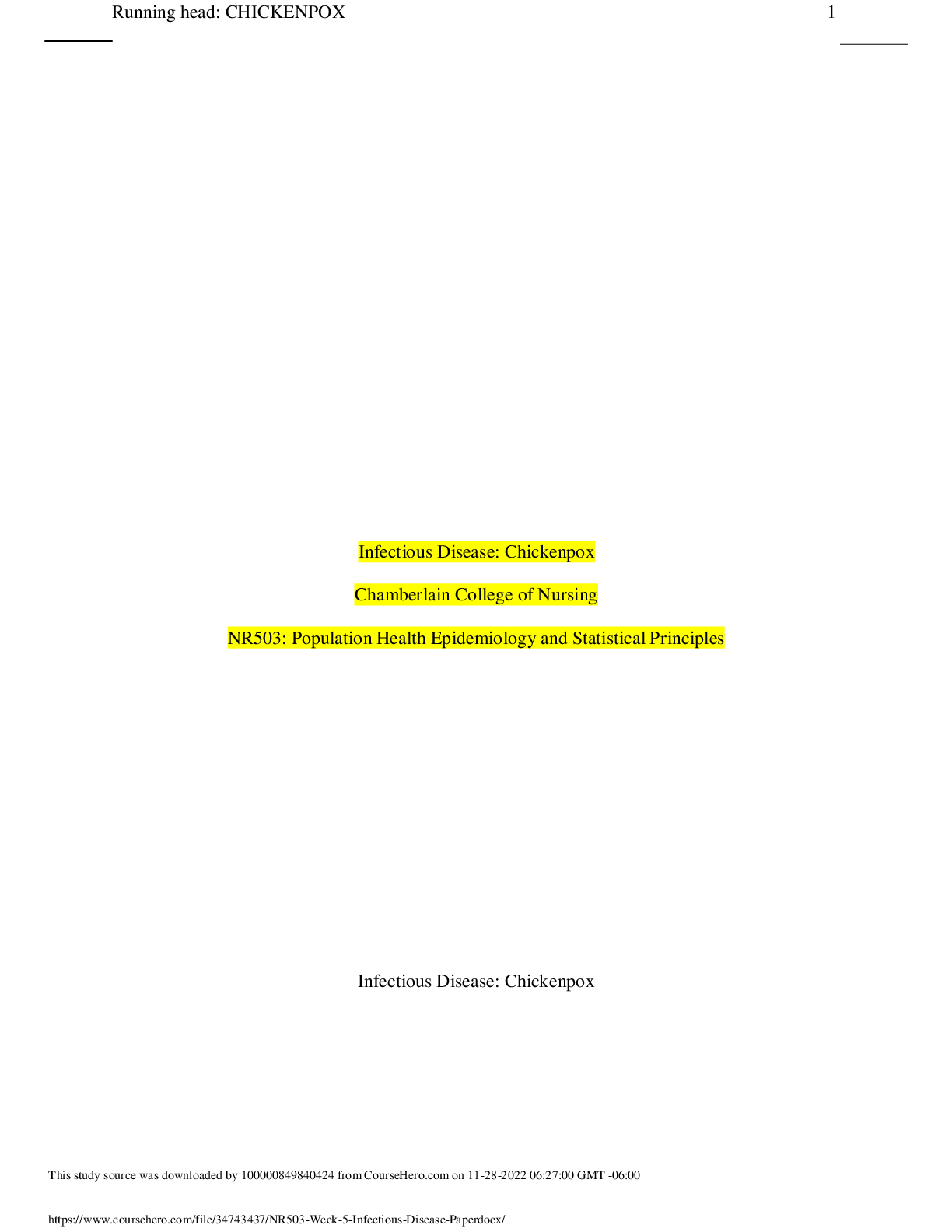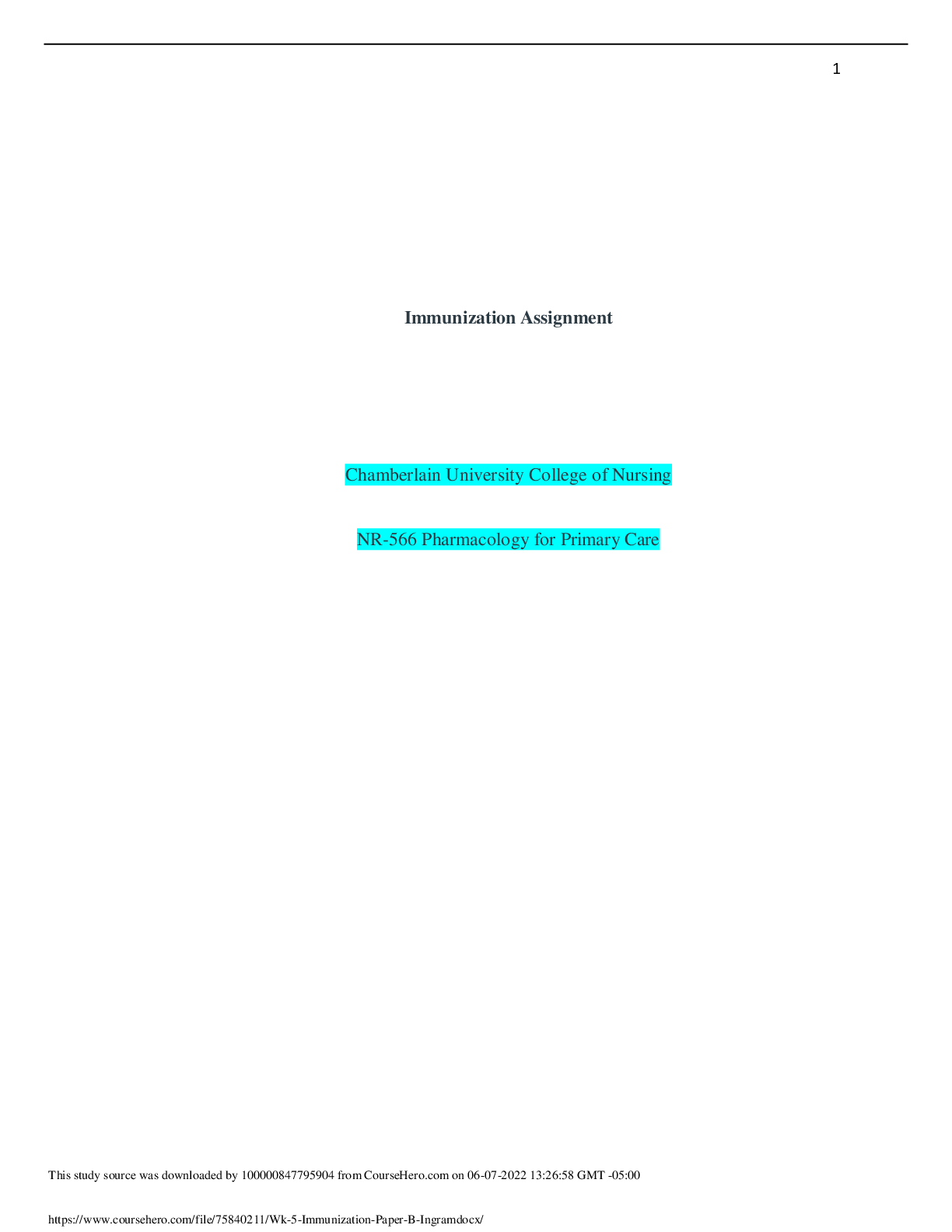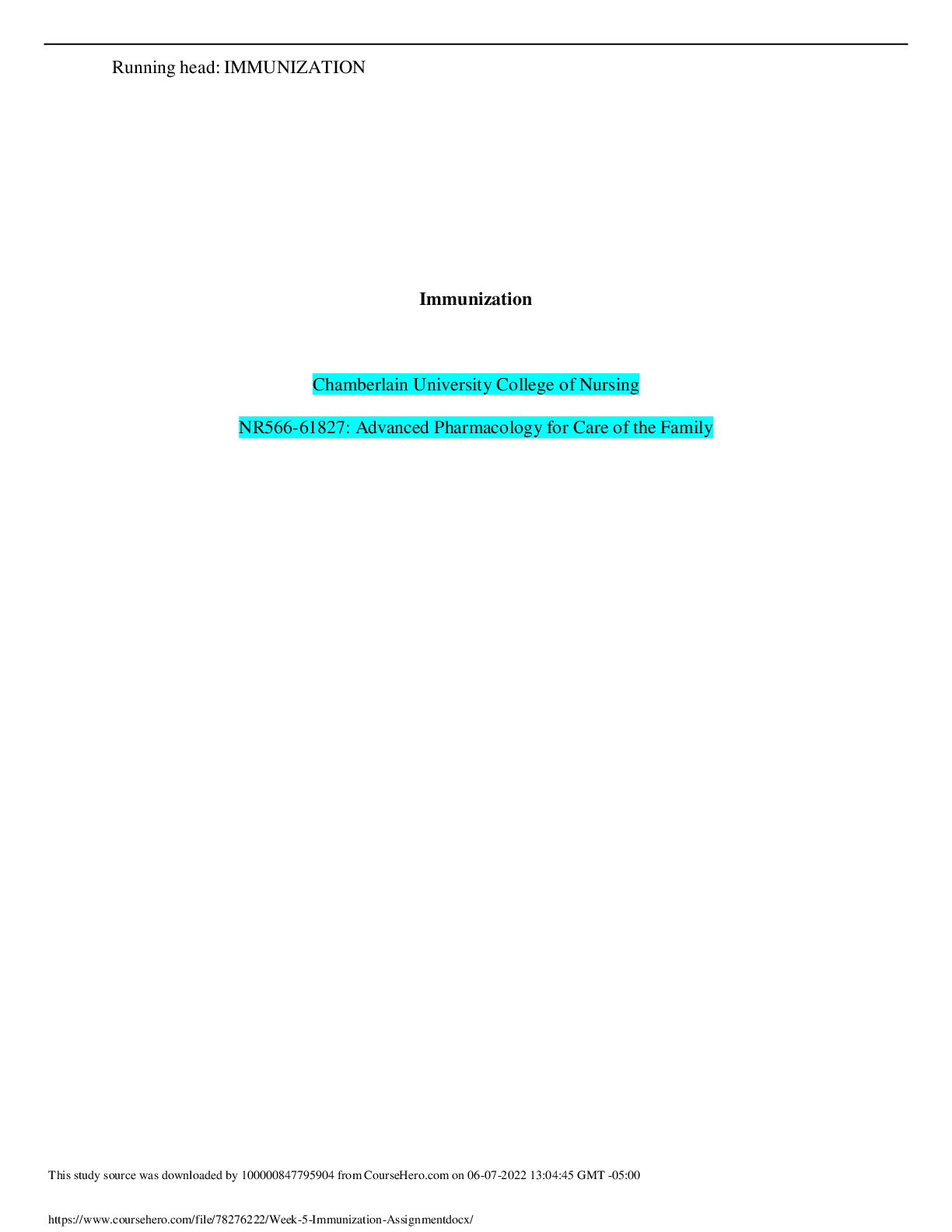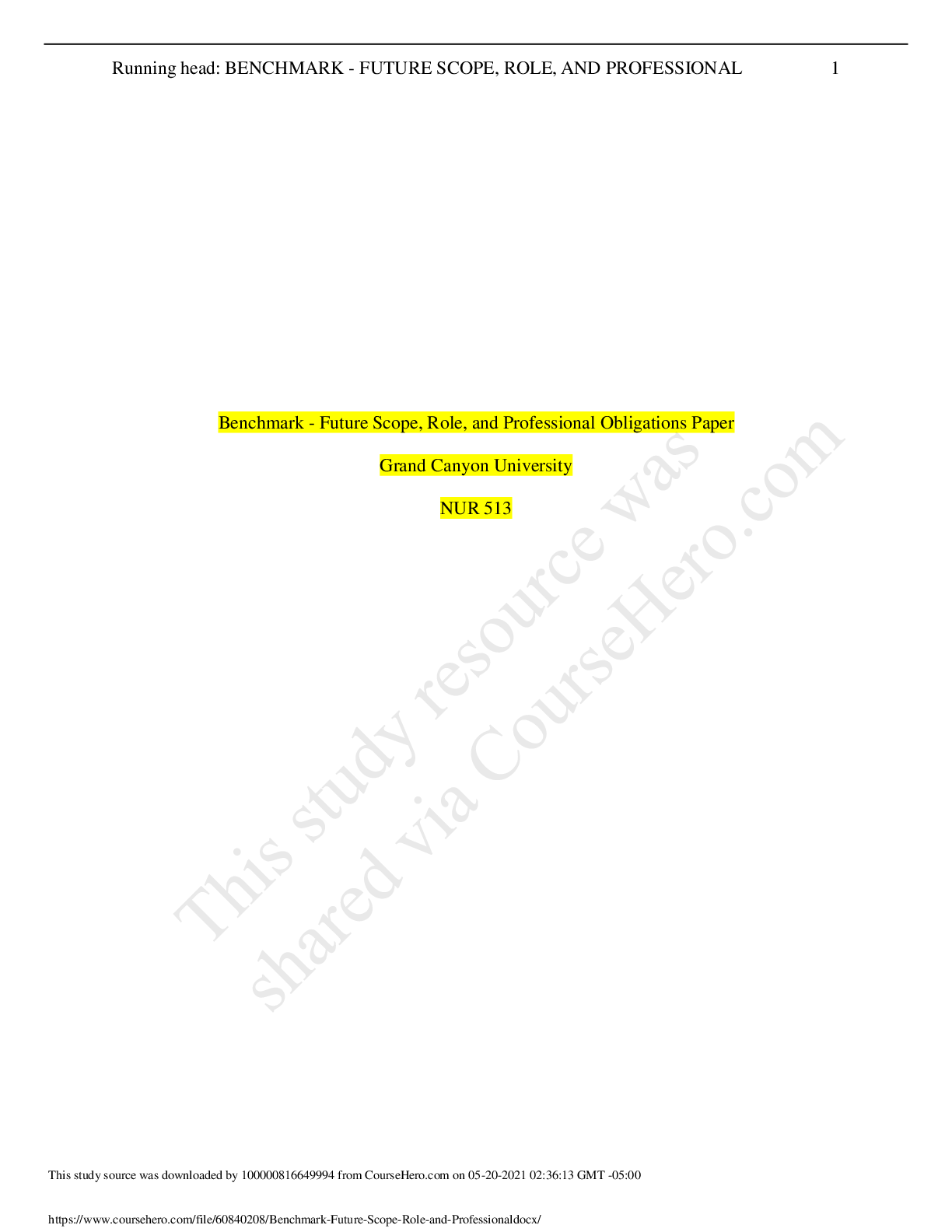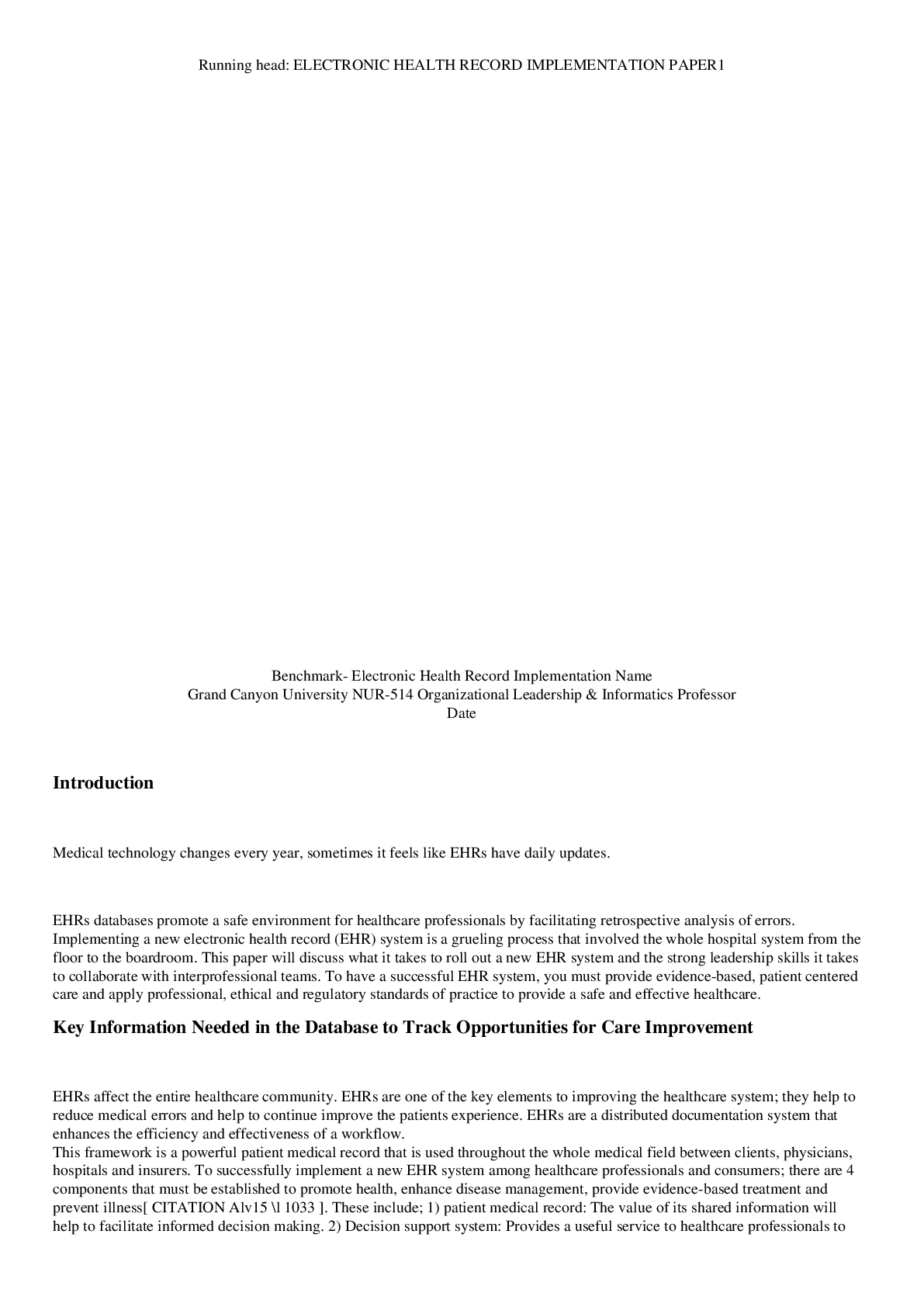*NURSING > ESSAY > NUR 514 Topic 8 Assignment Benchmark , Electronic Health Record Implementation Paper.(GRADED A) (All)
NUR 514 Topic 8 Assignment Benchmark , Electronic Health Record Implementation Paper.(GRADED A)
Document Content and Description Below
Benchmark - Electronic Health Record Implementation Paper Grand Canyon University: NUR 514 Benchmark - Electronic Health Record Implementation Paper Implementing a new electronic health r... ecord (EHR) system is a Herculean task for all the stakeholders: from the emergency room to the boardroom. This paper will discuss the need for excellent leadership skills to collaborate on interprofessional teams and to provide evidence- based, patient centered care and apply professional, ethical and regulatory standards of practice to provide of safe, effective healthcare. Effective leadership skills and the use of appropriate change management theories are required for successful EHR system implementation. Data management and informatics A computer system database will need to receive structured and litigable information that can be searched easily to track opportunities for care improvement. EHR as a clinical information system is a comprehensive system that includes easy access to patient data at the point of care, structured and litigable information that can be searched easily and that lends itself to data mining and analysis; and improved patient safety, especially the prevention of adverse drug reactions and the identification of health risk factors, such as falls (DeNisco & Barker, 2015, p. 357). Nursing documentation pre-date the days of Florence Nightingale. Over time nursing documentation has increased in its relevance to nurses and health care professionals, and its impact on patient care and patient outcomes. The mode of documentation has changed, from a paper trail to an electronic trail. Health informatics is the management of health information and uses information technology (IT) to organize health records to improve health outcomes and manage data collection from patient records. It is the responsibility of health informatics nurses to manage, interpret and communicating the health information, with the primary purpose of improving the quality of care. Three (3) key ways that informatics has improved care is with improved documentation, improved coordinated care and reduction of medical errors (Rupp, 2014). The care of the patient starts with the collection of patients’ medical history, clinical symptoms, allergy histories and latest medication list. This information is collected and documented in the electronic database. Nurses and other medical professionals are able to retrieve and record the information in real time. Thus, reducing medication errors with the integration of “soft stops”, alerts of medication allergies and interaction medications is one of the ways to improve patient care and have a comprehensive clinical system, which is a great asset. Required regulations in EHR system implementation A multidisciplinary team approach will be required, to ensure all required regulations mandated by the federal government from the privacy and security compliance, design practice workflows, training of care teams and managing the adoption process of EHR system implementation are followed (Hodgkins, 2015). A leader is needed to manage a multidisciplinary team. Servant leadership is of the types of transformative leadership that leads to success. Servant leadership is not a new idea as healthcare and servant leadership are natural partners. It is an effective way of leadership to guide the multidisciplinary team. The servant leader is servant first whose conscious choice brings him/ her to lead the multidisciplinary team, which will involve internal and external stakeholders. The internal stakeholders are the physicians, nurses, medical and nursing assistants, information technology staff, EHR developers, and administrative staff. External stakeholders are the patients, external EHR vendors, and software companies. The following are three important roles to consider: 1. Lead Physician: Guides the organization throughout the implementation; 2. Project Manager: Works closely with the vendors and all staff in practice to track progress and day to day issues; 3. Lead Super User: Functions as the in-house expert in the new EHR (Hodgkins, 2015). Professional, ethical, regulatory standards requirements “Patient care” is complicated by the governing privacy laws and ethical concerns. HIPPA, Health Insurance Portability and Accountability Act of 1996 is a federal law that protects health information. The HIPAA privacy and security rules protect the privacy and security of individually identifiable health information. The privacy rule covers protected health information in any medium, while the security rule covers electronic protected health information (HealthIT, 2019). Within the USA, the web of complicated legal and ethical laws has made it very challenging especially in the expanding field of health-related research, in the field of patient- centered outcomes research (PCOR). The Office of National Coordinator for Health Information Technology (ONC), created a new chapter titled “Legal and Ethical Architecture for PCOR Data” under the Privacy and Security Framework for PCOR in 2017 (HealthIT, 2019). This Architecture is designed to help stakeholders navigate the legal and ethical landscape for PCOR. Among the three (3) core ethical principles in medical ethics-beneficence, justice, and respect for persons -- the most significant principle in this Architecture is respect for persons, which encompasses both the principle of individual autonomy and the principle of protection of those with diminished autonomy. This is the basis for the practice of informed consent. The consent process for any medical treatment or participation in research must include sufficient information for the patient or participant to understand the procedure, risks, benefits, alternative courses available, and the fact that they can revoke consent at any time (The George Washington University, 2017). Order Sets and Communication Evidence-based practice is the current practice in health care. The current use of clinical order sets with adherence to evidence-based guidelines within EHR have shown reduction of errors and improved outcomes. For effective and updated order sets, the EHR team will have to ensure that all order sets are incorporated into the system. Ensuring success in this venture, buy- in and satisfaction from physicians, a formal governance structure led by the Lead Physician must be established. Clinical order sets should represent best practices and organizational standards which includes identifying and selecting data content sources, content review, maintenance and update. This is particularly true whenever clinical content is highly customized as it will require significantly more time and effort to maintain the customized content. There needs to be a process in place to identify and replace content that can affect patient safety or quality of care when content is outdated (Bushman, 2018). Communication is an important tool. Change management is a set of principles, techniques and prescriptions applied to the human aspects of executing major change initiatives. It is not just the “what” -- the information that needs to be communicated, but also the “how” -- to preparing the people to absorb the implications affecting them, and the “when” -- timing the communication that should happen (Creasey, 2018). For change to happen, it helps if the whole organization really wants it. There must be a sense of urgency around the need for change. This may help you spark the initial motivation to get things moving. Using John Kotter’s 8- Step Model for effective change, we can produce the spark to move the change. Kotter's 8-Step Model for effective change can park the move for change. The eight (8) steps are: Step 1: Create Urgency Step 2: Form a Powerful Coalition Step 3: Create a Vision for Change Step 4: Communicate the Vision Step 5: Remove Obstacles, Step 6: Create Short-Term Wins Step 7: Build on the Change Step 8: Anchor the Changes in Corporate Culture (Mindtools content team, 2019). New technologies have improved the ways we communicate. To implement a new EHR system, multiple ways of communication is needed to inform the stakeholders of changes that are coming their way. Multiple layers of advertisement from banners, posters, and flyers to individual emails should be delivered. Emails is a quick and efficient way for interprofessional teams to communicate. It can be used in your mobile devices as well as on a personal computer, can be encrypted for better security, and contain large graphic files and other attachments. This allows each team member to read and enter their input. Mobile text messages are another way for interprofessional teams to communicate. It is a quick and efficient way to get solutions on the go. Evaluation of the success of EHR implementation Prior to the implementation, a set of parameters of what success will look like should be developed. John Kotter’s 8- Step Model for effective change, can provide a guideline for the milestones at every step of the implementation. Short wins and establishing milestones are some goals that can be set in the initial plan prior to implementation. Some milestones and goals that can be set are assessing the internal stakeholders’ readiness to make the transition, planning how to “go-live” based on the assessment and achieving meaningful use. Careful preparation at the outset is key to a successful EHR implementation but having a set of realistic expectations and a manageable timeline is important. Once implementation is complete, a continued tracking is needed to gauge how the internal stakeholders are using the new system. This tracking will ensure continued successful EHR implementation (Kushan, 2017). Conclusion Implementation of a new EHR system will take careful planning, getting buy-in from all the stakeholders and using change management tools to move the change forward. Mapping out the implementation of this new EHR system as a journey not just a destination will ensure success. Good communication and effective leadership are key factors for a successful implementation of new EHR system. Servant leadership, which is being a servant first to lead the team and using John Kotter’s 8- Step Model for effective change, to manage the people side of the implementation, will aid the whole organization to understand, commit to and embrace changes of the new EHR implementation. References Bushman, S. (2018, December 5). Three Steps for Success with Clinical Order Sets. Retrieved from https://www.optimumhit.com/insights/blog/ehr-implementation/3-steps-success- clinical-order-sets Creasey, T. (2018). What is change management? Retrieved from http://www.howtochangemanagement.com/p/what-is-change-management.html DeNisco, S. M., & Barker, A. M. (2015). Advanced Practice Nursing (3rd ed.). Burlington, MA: Jones & Bartlett Publishers. Health IT. (2019). Health IT Legislation | HealthIT.gov. Retrieved from https://www.healthit.gov/topic/laws-regulation-and-policy/health-it-legislation Hodgkins, M. (2015, March 29). Electronic Health Record (EHR) Implementation. Retrieved from https://edhub.ama-assn.org/steps-forward/module/2702512 Kushan, D. (2017, December 4). How to Track and Measure Success During an EHR System Transition. Retrieved from https://www.healthcareis.com/blog/how-to-track-and- measure-success-during-a-transition Mind Tools Content Team. (2019). Kotter's 8-step change model. Retrieved from https://www.mindtools.com/pages/article/newPPM_82.htm ReThinkPhil. (2017). Servant leadership: A journey, not a race. Retrieved from https://healthmanagement.org/c/healthmanagement/issuearticle/servant-leadership-a- journey-not-a-race Rupp, S. (2014, November 14). How Nurses Are Using Health Informatics to Improve Patient Care. Retrieved from https://electronichealthreporter.com/nurses-using-health- informatics-improve-patient-care/ The George Washington University. (2017, September 28). Legal and Ethical Architecture for PCOR Data. Retrieved from 02/PCOR%20Architecture_Chapter%201_S_ONC %20FINAL.pdf [Show More]
Last updated: 2 years ago
Preview 1 out of 10 pages

Buy this document to get the full access instantly
Instant Download Access after purchase
Buy NowInstant download
We Accept:

Also available in bundle (1)

NUR 514 COURSE ASSIGNMENT WEEK 2, 3, 5, 6 AND 8 BUNDLE Deal (100% correct answers
NUR 514 COURSE ASSIGNMENT WEEK 2, 3, 5, 6 AND 8 BUNDLE Deal (100% correct answers
By Goodluck Academia 2 years ago
$14.5
5
Reviews( 0 )
$11.00
Can't find what you want? Try our AI powered Search
Document information
Connected school, study & course
About the document
Uploaded On
Oct 18, 2022
Number of pages
10
Written in
Additional information
This document has been written for:
Uploaded
Oct 18, 2022
Downloads
0
Views
93


